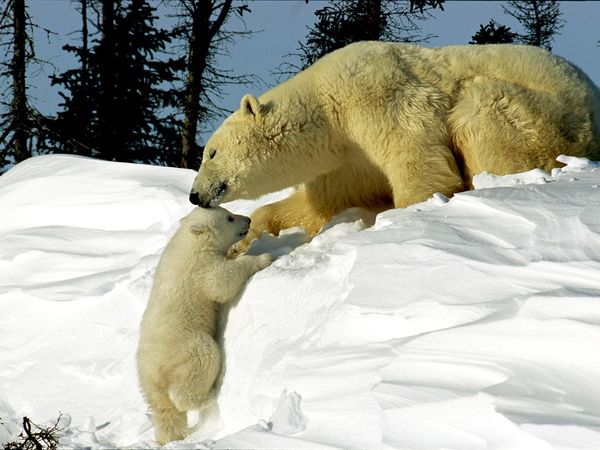
Although the ten species aren't those most at risk, IUCN selected them because they are well-researched "flagship" species that are being affected by a spectrum of climate change impacts, from melting sea ice to beach erosion.
(See pictures of the ten IUCN "flagship" species, and related pictures of ten U.S. species feeling global warming's heat.)
"The polar bear has become an icon of climate change, and it's doing a fabulous job," report co-author Wendy Foden of IUCN's Species Programme said by phone in Copenhagen.
But "there are other species too [that] help to highlight what climate change is doing."
Sea Turtle Gender Bending
Many of the animals featured in the new report already appear on IUCN's Red List of Threatened Species for other reasons, such as habitat destruction and overharvesting. This makes climate change an "additional and major threat," the report authors say.
For instance, critically endangered leatherback sea turtles are already at risk of becoming entangled in fishing nets or choking on plastic debris in the ocean.
In a warmer world, the sea turtles must also try to nest on beaches severely eroded by extreme storms, which have been linked to rising sea-surface temperatures.
See video portraits of the ten IUCN "flagship" species.
In addition, a hatchling turtle's gender is determined by the average temperature during the egg's development—and hotter sand is spawning a disproportionately high number of females.
(Related: "Warming May Drive Gender-Bending Reptiles Extinct, Scientists Say.")
Bleaching, Tannins, and Ice Melt Perhaps the most vulnerable species on the new list is the staghorn coral, which has been greatly weakened by bleaching, IUCN's Fodel said.
Bleaching occurs when warmer oceans cause corals to lose their symbiotic algae, leaving the blanched reefs to slowly perish.
At the same time, coral declines mean that another of the report's threatened species, the clownfish, is suffering from lost habitat.
Meanwhile, rising carbon dioxide in the atmosphere is causing eucalyptus plants in Australia to produce leaves with fewer nutritious proteins and more unpalatable tannins.
This means that koalas, which eat only eucalyptus, will have to consume even more to keep from starving.
"We definitely didn't anticipate that one," Fodel said.
And like the polar bear, several of the report's species—such as the arctic fox, emperor penguin, beluga whale, and ringed seal—depend on polar snows and ice for their survival.
No one knows what will happen to some these species when polar summer ice completely disappears—which may occur in the Arctic by 2040, experts say.
The report's other at-risk species include the African quiver tree, under threat due to drought, and salmon, whose home streams may experience changes in flow rate due to earlier snow melt.
"Weedy" Species to Thrive With Warming?
Some species—such as mosquitoes and jellyfish—are thriving due to global warming, experts note.
But such species tend to be the "weedy, invasive types" that may create serious problems if they explode in numbers, Fodel said.
Mosquitoes in Africa, for instance, are already expanding their ranges due to climate changes—bringing more malaria with them.
These opportunists may throw off ecosystems and put further stress on weakened species.
"While it is true that some species will benefit, that will be an overwhelmingly negative thing for biodiversity," said Kassie Siegel of the Center for Biological Diversity, a California-based nonprofit.
Adaptable
Co-author Fodel emphasized that the species in the new report are not yet in dire straits: The ringed seal, for example, is still the most common seal in the Arctic.
"They can adapt—it's a question of whether climate change is slow enough for them to adapt," she said.
And that may rest on the outcome of this week's climate talks, which end Friday, said the Center for Biological Diversity's Siegel.
As of Monday, the draft negotiations would allow Earth's carbon dioxide levels to rise to 650 parts per million by 2100, which in turn would warm the Earth by up to 5.4 degrees Fahrenheit (3 degrees Celsius) by the same year, scientists estimate.
That, Siegel said, would "equal extinction for essentially all of these species, plus thousands of others."
From;
National Geographic News







No comments:
Post a Comment